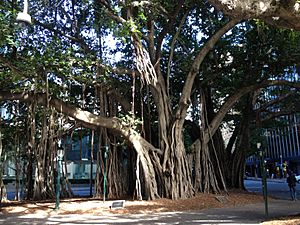Eagle Street Fig Trees facts for kids
Quick facts for kids Eagle Street Fig Trees |
|
|---|---|

Eagle Street Fig Trees, 2013
|
|
| Location | 118A Eagle Street, Brisbane City, City of Brisbane, Queensland, Australia |
| Design period | 1870s - 1890s (late 19th century) |
| Built | c. 1889 |
| Official name: Eagle Street Fig Trees, Fig Tree Reserve, Plantation Reserve | |
| Type | state heritage (landscape) |
| Designated | 13 May 2004 |
| Reference no. | 602440 |
| Significant period | c. 1889 (historical) |
| Significant components | plaque |
| Gardener | Walter Hill |
| Lua error in Module:Location_map at line 420: attempt to index field 'wikibase' (a nil value). | |
The Eagle Street Fig Trees are a special group of trees in Brisbane City, Queensland, Australia. These trees are considered important heritage because they were planted a long time ago, around 1889. They were planted by a famous gardener named Walter Hill. This area is also known as Fig Tree Reserve or Plantation Reserve. The trees were added to the Queensland Heritage Register on May 13, 2004, which means they are protected because of their historical importance.
Contents
History of the Fig Trees
This small, triangle-shaped piece of land is located where Eagle, Elizabeth, and Creek Streets meet. It was given to the Brisbane Municipal Council by Queen Victoria on May 16, 1889. The document was signed by the Governor of Queensland, Sir Henry Wylie Norman.
The land was officially announced on May 17, 1889. It was set aside as a "Reserve for Plantation, urinal etc. only." This meant it could only be used for planting trees and public toilets, and nothing else. The agreement also stated that if these rules were not followed, the land could be taken back by the Crown.
Walter Hill was the person who planted the three fig trees you see there today. He was Brisbane's first superintendent of the Brisbane Botanic Gardens. He started this important job in 1855 and continued to manage the Gardens until 1881.
Public toilets were built on the reserve, but they were removed in the 1970s. Today, the area has paved paths, old-fashioned streetlights, and things like garbage bins and seats for people to use.
What the Reserve Looks Like
The reserve is a triangular island of land. It sits right at the busy intersection of Eagle, Elizabeth, and Creek Streets. This spot has paved areas and gardens. The most striking feature is the huge fig trees. They create a beautiful and noticeable effect in the busy business area around Eagle Street.
There are three fig trees planted here. Two of them are White Figs (called Ficus virens). The third one is a Banyan Fig (known as Ficus benghalensis). The Banyan Fig trees have special "prop roots." These roots grow down from the branches to the ground. They help support the heavy branches and also collect moisture from the air. The White Fig trees are taller than the Banyan Figs. They have light green leaves that first appear in shades of pink or bronze. This type of fig tree grows naturally in Queensland and other tropical parts of Asia.
You can also find two bronze plaques at the site. The first plaque is on a small stand. It has words carved into it that describe what the area was like in 1889. It also tells the history of the site before 1889 and how it was used for business activities. The second plaque shows a map. This map illustrates the path of a creek that used to flow through this very spot.
Why These Trees Are Heritage Listed
The Eagle Street Fig Trees were added to the Queensland Heritage Register on May 13, 2004. This means they are important for several reasons:
Showing Queensland's History
The Eagle Street Fig Trees help us understand how Queensland's history has changed over time. This "Plantation Reserve" is important because it is a small part of how the area developed in the mid-1800s. Old photos of the area show many horses and carts lined up. They were there to serve the nearby wharf and warehouses. The reserve was created in the late 1800s. It gave a place for workers and carriers to rest and relax in a very busy area.
A Rare Part of Queensland's Culture
These fig trees are a rare example of a mid-Victorian era reserve. They show a unique part of Queensland's cultural heritage. Located in a busy trading area, the Eagle Street Fig Trees offered a peaceful break for workers from the hectic wharf. The trees still serve this purpose today, providing a calm spot in a busy city.
Their Beautiful Appearance
The Eagle Street Fig Trees are a landmark. They stand out at the intersection of several major streets in Brisbane's city center. They provide welcome shade and make the area look more beautiful.
Plaques




